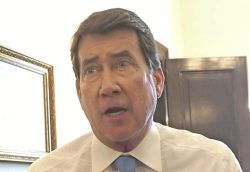BOJ’s Monetary Policy: It’s Time to Usher in A Genuine ‘World with Interest Rates’
14:55 JST, August 1, 2024
The Bank of Japan has taken its monetary policy another step into a full-fledged “world with interest rates.” Hopefully, the central bank will manage its policies by carefully checking trends in the economy and prices.
The BOJ has decided to raise its policy interest rate to around 0.25% in August from the current range of around zero to 0.1%. The central bank has judged that since the negative interest rate policy was lifted in March this year, prices are on an upturn and the economy is strong.
Although the BOJ has been purchasing about ¥6 trillion of Japanese government bonds per month, it plans to halve that to about ¥3 trillion in the January-March 2026 period by phasing down the amount of purchases.
Commenting on the interest rate increases at a press conference, BOJ Gov. Kazuo Ueda explained: “It is appropriate to adjust the degree of monetary easing. I don’t think the rate increase will suddenly slow down the economy.”
The highest wage increase levels in 33 years were realized in this year’s shunto spring wage negotiations, and there is a possibility that the yen’s depreciation could cause prices to swing higher than expected. It is likely that the BOJ took into consideration the risk that ultralow interest rate policies combined with high prices would increase the effects of monetary easing and stimulate the economy more than necessary.
Household budgets are tight due to prolonged high prices as the weak yen raises the cost of imported goods. Raising interest rates may also have the effect of correcting the excessive depreciation of the yen.
The BOJ’s monetary easing measures had become the norm as deflation became more prolonged.
With that plus the effects of the weaker yen, Japan’s nominal gross domestic product in 2023 fell to fourth place worldwide in dollar terms, with Germany’s GDP overtaking it.
The Japanese economy is now in a phase in which it should shift from a “cost-cutting economy,” in which labor and other costs are reduced to sell underpriced products, to a “growth-oriented economy,” in which wages and investment increase.
To realize a vibrant Japanese economy, it is important for the BOJ to proceed with the normalization of monetary policy.
A concern going forward is the weakness of private consumption. Real GDP shrank an annualized 2.9% in the January-March period, and private consumption has been below the previous quarter for four consecutive quarters.
Real wages, adjusted for price fluctuations, have seen negative growth for more than two years, and consumers also appear to be suffering “price increase fatigue.”
Interest rate increases could raise mortgage rates and cool consumption. In addition, there are concerns that small and midsize enterprises will have difficulty securing cash. It is hoped that the BOJ will carefully pay attention to the economy to determine the timing of additional interest rate increases.
The BOJ says that the rate of increases in the consumer price index has been above the 2% target for more than two years — but also that this is due to temporary factors, meaning that the inflation target has not yet been achieved. It is an issue on which the BOJ’s explanations are not in line with what the public really feels. The central bank needs to provide more thorough explanations.
(From The Yomiuri Shimbun, Aug. 1, 2024)
"Editorial & Columns" POPULAR ARTICLE
-

Artificial Intelligence Expands Possibilities for Foreign Language Learners
-

Build Intellectual, Physical Strength, As Well As Communicative Power / Japan Should Move from Beneficiary to Shaper of World Order
-

Global Economy in Turmoil: Prevent Free Trade System from Going Adrift / Risks to Financial Markets Must Be Heeded
-

Japan-China Strain Set to Persist as Beijing Officials Self-Interestedly Bash Tokyo; Takaichi Unlikely to Back Down
-

Elderly People Living Alone: What Should be Done to Ensure Living with Peace of Mind until the End?
JN ACCESS RANKING
-

BOJ Gov. Ueda: Highly Likely Mechanism for Rising Wages, Prices Will Be Maintained
-

Japan Govt Adopts Measures to Curb Mega Solar Power Plant Projects Amid Environmental Concerns
-

Core Inflation in Tokyo Slows in December but Stays above BOJ Target
-

Major Japan Firms’ Average Winter Bonus Tops ¥1 Mil.
-

Bank of Japan Considered U.S. Tariffs, Coming Shunto Wage Hike Talks in Its Decision to Raise Interest Rates

























